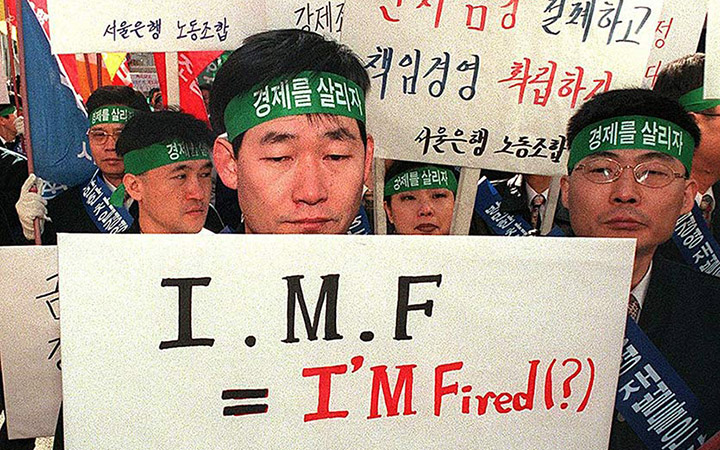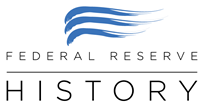Asian Financial Crisis
July 1997-December 1998

On July 2, 1997, Thailand devalued its currency relative to the U.S. dollar. This development, which followed months of speculative pressures that had substantially depleted Thailand's official foreign exchange reserves, marked the beginning of a deep financial crisis across much of East Asia. In subsequent months, Thailand's currency, equity, and property markets weakened further as its difficulties evolved into a twin balance-of-payments and banking crisis. Malaysia, the Philippines, and Indonesia also allowed their currencies to weaken substantially in the face of market pressures, with Indonesia gradually falling into a multifaceted financial and political crisis. Hong Kong faced several large but unsuccessful speculative attacks on its currency peg to the dollar, the first of which triggered short-term stock market sell-offs across the globe. And severe balance-of-payments pressures in South Korea brought the country to the brink of default.
Across East Asia, capital inflows slowed or reversed direction, and growth slowed sharply. Banks came under significant pressures, investment rates plunged, and some Asian countries entered deep recessions, producing important spillovers to trading partners across the globe.
The events that came to be known as the Asian Financial Crisis generally caught market participants and policymakers by surprise. While some vulnerabilities were well recognized before the crisis erupted, especially in Thailand, these countries' economies were also viewed as having many strengths. Indeed, the most affected economies were among the world's most successful in the decade heading into the crisis. Business-friendly policies and cautious fiscal and monetary management had translated into high rates of savings and investment, supporting GDP growth rates exceeding 5 percent and often approaching 10 percent.
However, as the crisis unfolded, it became clear that the strong growth record of these economies had masked important vulnerabilities. In particular, years of rapid domestic credit growth and inadequate supervisory oversight had resulted in a significant build-up of financial leverage and doubtful loans. Overheating domestic economies and real estate markets added to the risks and led to increased reliance on foreign savings, reflected in mounting current account deficits and a build-up in external debt. Heavy foreign borrowing, often at short maturities, also exposed corporations and banks to significant exchange rate and funding risks—risks that had been masked by longstanding currency pegs. When the pegs proved unsustainable, firms saw sharp increases in the local currency value of their external debts, leading many into distress and even insolvency.
Bibliography
Board of Governors of the Federal Reserve System. "FOMC: Transcripts and Other Historical Materials, 1997." Last updated August 2, 2013, https://www.federalreserve.gov/monetarypolicy/fomchistorical1997.htm.
Board of Governors of the Federal Reserve System. "FOMC: Transcripts and Other Historical Materials, 1998." Last updated August 2, 2013, https://www.federalreserve.gov/monetarypolicy/fomchistorical1998.htm.
Boughton, James. Tearing Down Walls: The International Monetary Fund, 1990 - 1999. Washington, DC: International Monetary Fund, 2012.
Blustein, Paul. The Chastening: Inside the Crisis that Rocked the Global Financial System and Humbled the IMF. New York: PublicAffairs, 2001.
Corsetti, Giancarlo, Paolo Pesenti, and Nouriel Roubini, "What Caused the Asian Currency and Financial Crisis? Part I: A Macroeconomic Overview," NBER Working Paper 6833, National Bureau of Economic Research, Cambridge, MA, 1998.
Corsetti, Giancarlo, Paolo Pesenti, and Nouriel Roubini, "What Caused the Asian Currency and Financial Crisis? Part II: The Policy Debate," NBER Working Paper 6834, National Bureau of Economic Research, Cambridge, MA, 1998.
Fischer, Stanley. IMF Essays from a Time of Crisis: The International Financial System, Stabilization, and Development. Cambridge: MIT Press, 2004.
Rhodes, William. Banker to the World: Leadership Lessons from the Front Lines of Global Finance. New York: McGraw-Hill, 2011.
Rubin, Robert, and Jacob Weisberg. In An Uncertain World: Tough Choices from Wall Street to Washington. New York: Random House, 2003.
Written as of November 22, 2013. See disclaimer and update policy.


 X
X  facebook
facebook
 email
email